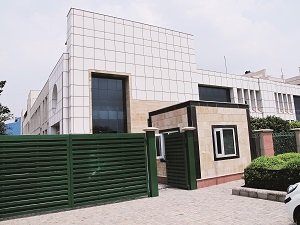
Rave India started in 1993 as a prepress house in Delhi that eventually had five high-end scanners and five imagesetters. Since September 2005, with the installation of a new 5-color SpeedMaster 74 press it has been one of the fastest growing printers in the country. The company now has two plants – in Delhi and Manesar. The company recently installed a new Heidelberg Speedmaster CD 102-6 color plus coater UV combination press with Foilstar at its plant in Manesar.
The country’s first Heidelberg Speedmaster CD 102-6 color plus coater UV combination press with Foilstar – the 59th Heidelberg Foilstar installation in the world – is now up and running and has already delivered a few jobs to Rave’s clients. Seen from the road, Rave’s new 150,000 square foot plant in Manesar resembles a giant multinational’s building.
 With Rave’s plant in Gurgaon now being relocated to Manesar, the new location will take another month and a half to be completely ready and operating with full force. According to Bhatnagar, the Manesar plant will cater to both packaging as well as commercial printing customers. It is equipped with a number of Heidelbergs in addition to the new 6-color – a 4-color SM74, two 4-color CD102s, an 8-color SM 102. And for finishing, converting and binding – an MC2004, a Bobst Novacut 106 E, a Vision Fold, and Stahl Folder, Muller Martini Presto II, Aster, Eurobind, Welbound, Gattering, Sakurai, Polar’s, Polar System, all distributed to three levels of the building.
With Rave’s plant in Gurgaon now being relocated to Manesar, the new location will take another month and a half to be completely ready and operating with full force. According to Bhatnagar, the Manesar plant will cater to both packaging as well as commercial printing customers. It is equipped with a number of Heidelbergs in addition to the new 6-color – a 4-color SM74, two 4-color CD102s, an 8-color SM 102. And for finishing, converting and binding – an MC2004, a Bobst Novacut 106 E, a Vision Fold, and Stahl Folder, Muller Martini Presto II, Aster, Eurobind, Welbound, Gattering, Sakurai, Polar’s, Polar System, all distributed to three levels of the building.
The star of the Manesar plant is the elegant Heidelberg Speedmaster CD 102-6 color plus coater UV combination press with Foilstar. “We have given the market an option which is something very new. After accomplishing a few jobs on the Foilstar, we have seen that the output is far better than metallized printing because in Foilstar you can combine both conventional and metallized printing. The Foilstar can deliver sophisticated security features, and is much more environment-friendly,” says Bhatnagar.

Simple yet technologically advanced, the new press comes with third generation Foilstar technology. In the press, cold foil is applied in-line using two of the offset printing units, thus providing advantages of offset printing such as CtP imaged plates for foil, fast makeready, quick changeover, low maintenance and low energy consumption. The first unit transfers adhesive that is picked up by the offset plate instead of ink and the second unit removes the foil from a ribbon or ribbons of cold foil running in the Foilstar.
This is not the first time that Rave has invested in a new technology. While setting a cue for others to follow, readiness in adopting new technology is what makes Rave Scan a leader – be it quality, exclusivity, just-in-time or quantity. “Investing in new technology is not just risk-affiliated, but also challenging. However, we are optimistic and quite sure that once the market adapts to what we deliver with our new technologies, there is going to be a huge triumph,” says Bhatnagar.
“New technology means new features which requires time and a lot of R&D to learn and master these features. But we gain the benefits of new technology in terms of increased sales. If everything goes well, new technology will help us in sustaining the growth of the company through technical strength. Technical strength, coupled with good intention and hard work is what is needed to crack the market,” concludes Bhatnagar.










